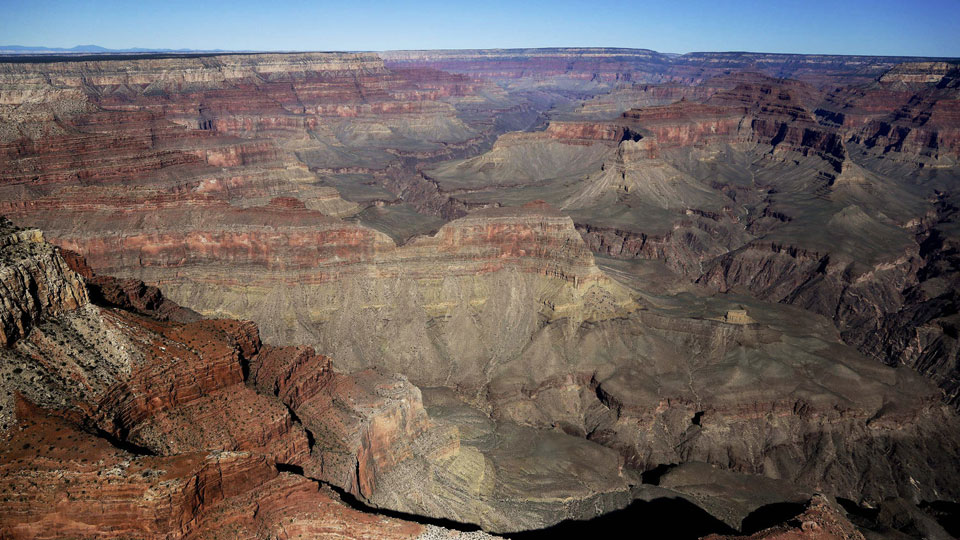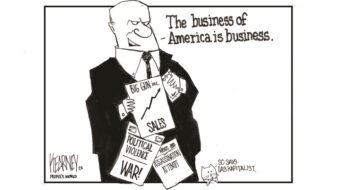
WASHINGTON—If the “income gap” between the rich and the rest of us is a chasm, then the less-discussed “wealth gap”—especially between whites and African Americans—is the Grand Canyon.
At least that’s what the figures show in a new report from the Institute for Policy Studies, the third in its series comparing income and wealth between whites and the rest of us.
IPS released How Enriching the 1% Widens the Racial Wealth Divide, to honor Dr. Martin Luther King Jr. on his actual birthday, Jan. 15. Had King lived – white nationalist/racist James Earl Ray assassinated him in Memphis in 1968 – the nation’s foremost civil rights leader would have turned 90.
In his “I‘ve Been to the Mountaintop” speech in Memphis the night before his murder, King stated, “The Negro lives on a lonely island of poverty in the midst of a vast ocean of material prosperity,” the IPS report’s four authors write.
“Dr. King also stated ‘America has given the Negro people a bad check, a check which has come back marked ‘insufficient funds.’ Over 50 years since this famous dream was shared with the nation, we have seen wealth concentrate among the wealthiest and a polarizing racial wealth divide grow between Whites and Blacks and Latinos.”
Key findings of the IPS report include:
- In inflation-adjusted dollars, the median wealth of a white family in the U.S. – the point at which half of white households are above and half below – was $146,984 in 2016, the last full year available. That’s up 33 percent in 33 years, from $110,160 in 1983. Median wealth, IPS notes, is a better measure than average wealth, since it reduces the outsize impact of higher-income families on the averages.
The median wealth for African-American families dropped by 52 percent, from $7,323 in 1983 to $3,557 in 2016. That’s despite a slight “recovery” after 2013: The Great Recession caused such a crash among African Americans that their families’ median wealth hit a bottom of $1,700 in 2013.
The median wealth for Latino families increased from $4,289 in 1983 to around $11,000 before the crash hit. It’s now $6,591.
- The combination of the low levels of median wealth for minorities and their increasing share of the population means the median family wealth – assets, such as houses, securities and savings accounts, minus all debts, such as mortgages and loans – of the entire U.S. went down in those 33 years, from $84,110 in 1983 to $81,704 in 2016. Unlike the federal data IPS relies on, its analysis excludes cars, since families can’t quickly convert them into wealth.
- Comparing the rich to the rest of us worsens the wealth gap. Three men – Jeff Bezos, Bill Gates, and Warren Buffett – now have more net wealth than the entire bottom half of the U.S. combined.
The top 1 percent of the U.S., including those three men, owned 39.6 percent of U.S. wealth in 2016, up from one-third 33 years before. The bottom 90 percent of the nation’s families owned 23 percent of all wealth compared to one-third in 1983 and 21 percent just before the Great Depression in 1929.
- Contrary to the “up from the bootstraps” and “self-made” myths of the rich, much of their wealth is inherited and then grew even larger. “Three dynastic wealth families – the Waltons, the Kochs and the Mars’s – have seen their dynastic wealth increase nearly 6,000 percent since 1982, compared to a 3 percent decrease for the median family.”
Though the report does not say so, the Waltons, of course, reign over venal, vicious, anti-worker and poverty-wage – or less – pay for workers at Walmart. The Kochs are the radical right-wing oil barons from Kansas City who fund conservative efforts and politicians to destroy workers and unions. The Mars family owns the candy company. Another dynasty: Donald Trump and his late father, Fred.
“The dynastic wealth of the Waltons grew from $690 million in 1983 — $1.81 billion in 2018 dollars — to $169.7 billion in 2018, a mind-numbing increase of 9,257 percent,” IPS reported. A median African-American family “would need over 52 million years to reach that level.”
- In the last 33 years, the richest 0.1 percent of the country grabbed one of every six dollars in wealth gains in the U.S. and the top 20 percent grabbed just about everything else: 97.4 percent of all wealth gains. That left 2.6 percent for the rest of us.
- You need net wealth of at least $2.1 billion to make the Forbes 400 list of the wealthiest people in the U.S. Two African Americans – investor Robert Smith ($4.4 billion) and Oprah ($2.8 billion) – make it. Michael Jordan, at $1.65 billion, doesn’t. Four Latinos make it, and two of them, Alejandro and Andrés Santo Domingo, inherited their wealth, $3.9 billion each, from their Colombian billionaire father.
- You’ve heard of “underwater mortgages,” right? Try “underwater families.” One in five U.S. families has a net wealth of zero or less. That’s up from one in six 33 years ago. But those one in five include 37 percent of African-American families and one-third of Latino families. The proportion of underwater African-American families rose three percentage points in 33 years. The share of underwater Latino families declined, from 40 percent in 1983. The white “underwater” share in 2016: 15 percent.
- Income findings, by race of family, are similar to the wealth gap. But African-American families’ income is much more dependent on Social Security: 46 percent of all income, double that of whites.
“Giving tax cuts to the wealthiest households and most profitable corporations, as the 2017 Trump tax cuts did, only exacerbates the racial wealth divide. We need to restore progressive tax rates on the wealthy that have been dismantled over the last several decades,” the IPS authors state. Their recommendations for closing the wealth gap include:
- Tax the rich, not the rest. “A 1 percent annual tax on the wealthiest 0.1 percent of households, those with wealth over $20 million, would generate an estimated $1.899 trillion in revenue over the next decade, according to a forthcoming report by the Institute for Taxation and Economic Policy.” And raising thresholds for tax exemptions now available to the poor to include more of the middle class would also help close the gap.
- Restore the inheritance tax. Trump’s $1.5 trillion tax cut for the rich virtually abolished it. The report’s authors recommend reversing that. “Taxing inherited wealth as income would help break up current and future wealth dynasties,” they commented.
- Taxing capital gains as ordinary income: “There remains no serious justification for taxing capital gains at significantly lower rates than we currently tax middle-class workers,” the report says. Though the writers did not say so, this proposal has been around since at least the 1972 presidential campaign, when Democratic nominee George McGovern declared, “Money made by money should be taxed the same as money made by man.”
- Positive legislation, including “A baby bond program to help low-wealth households build wealth,” the wealth tax, “an audit of federal government policies to evaluate their impact on the racial wealth divide,” and “targeted reparations to address the legacy of racism in wealth building.”












Comments